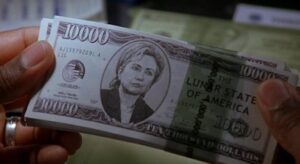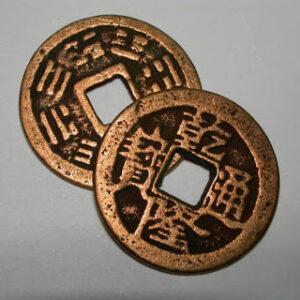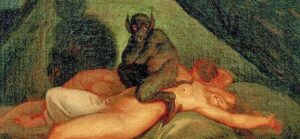“I prefer hard cash. If you can’t scratch a window with it I don’t accept it”.
Roosta: The Hitch-hiker’s Guide to the Galaxy. (Fit the Eighth)
Regular readers will know that on Fridays blog posts here tend to stray a little from the usual topics of self-defence and preparedness. Today is no exception and probably diverges even more than usual. It is, however, a logical progression from the recent post on the design of money.
Recently I was watching a certain sci-fi series and two of the characters offered another character a bribe. What was notable about this is that you saw them physically offering money. The money offered was only seen at a distance and appeared to be coloured plastic cards.
While money is often discussed in science fiction shows, I cannot recall that many incidences when you actually see the physical cash. (One exception to this that springs to mind is Pluto Nash and “the Hillarys”)

What kind of form might a future hard currency take?
The above example did illustrate that cash did not have to be paper, or even flexible polymer. When you might be on another planet to the mint, there is something to be said for an exchange medium that is more durable.
Coins are one of the oldest mediums of exchange.
The Chinese seem to have used the same basic design for more than a thousand years. The square hole in the centre seems to have been introduced as part of the production process, allowing a batch of coins to be threaded on a square rod for filing into their final shape. It had the added advantage that coins could be threaded on a string for easier bulk handling. This also resulted in the wide use of coins as ornaments or charms.
Coins from other countries show more variety but nearly all are circular or circle-like equilateral polygons.
Coins are convenient to carry in a pocket or pouch and can be stacked for bulk handling. Their shape also makes them suitable for vending machines and other coin-operated apparatus.
On the downside, coins are relatively heavy, which can be significant if handling large quantities.
The US military uses paper coins (technically “gift certificates”) in certain deployment areas. The use of these “Pogs” is to avoid the need to air-transport large quantities of coins. (The military might like to also consider removing chewing gum from the MRE packs and inventory in general as a non-productive item to save air-lift weight).
The weight of coins might not be a problem in an environment where most transactions are conducted electronically, since there would be less need to handle large quantities of physical cash.
I will discuss the implications of “e-cash” further in a moment.
A money exchange company designed some “space money” as a publicity stunt a few years back.
“The Quasi Universal Intergalactic Denomination – or Quid for short as interplanetary vernacular demands – had to be completely free of sharp edges, such as would be found on coins. Magnetic strips and electronic chips such as are found embedded within our credit cards would be also prove useless as they would be fried by cosmic radiation.
“In addition, the currency had to be completely independent of itself, unlike electronic banking, which would be useless in space due to the great distances signals would have to travel for confirmation, making for some rather lengthy check-out times.”
Very attractive, but somewhat bulky and they do not look like they will stack.
An alternative or supplement to coins might be a card-shaped currency as shown in the TV show I was watching.
Casino chips, for example, are supplemented by “plaques” for high denominations. Does a card-shaped currency need to use something the size of a credit card? No, it doesn’t.
A smaller card would allow more to be carried. The optimum size might be something like a stick of chewing gum, or more conveniently, the size of a Kimball tag, approximately 1" x 3". For want of any better term, let us call this format a “Kimball Note”.
A small plastic card along these lines would offer a number of advantages.
The obvious one is that it was inspired by a punched card and would readily lend itself to various types of mechanical handling ranging from counting machines to vending devices.
If you have ever tried feeding a bank note into a ticket machine you will know that they can be rather fussy in their diet. A rigid plastic card would be much easier to use.
The vending machine industry has sometimes suffered because their machines could only take small denomination coins. This new format of money would prevent this problem.
Like a punched card, a Kimball Note has one corner cut off so mechanical devices can detect its orientation. The other corners would be rounded to facilitate being carried loose in a pocket.
Notches in the edge of the note might be another identification feature and would allow one to verify at a glance that all the notes in a stack were of the same value.
A barcode embossed on the surface might further increase the ease with which machines can handle the cash.
“What about electronic transactions?” some of you may be asking.
You might regard the above suggestions as somewhat superfluous because in the future we will be in a cashless society.
We seem to be advancing along this route.
In many cities buses and other public transport no longer accept cash. Instead you present a travelcard to an electronic reader. In the past few years it has been possible to also pay by touching a “contactless” credit/debit card to the same reader. You can also now use your phone instead of a credit/debit card.
Banking apps allow you to use your phone to send money directly to someone’s bank account. Nearly everyone now carries a phone or similar device so it is only a matter of time before it will be commonplace to transfer money “phone-to-phone” in face to face transactions.
A “cashless” or “e-cash” society could have some interesting potential aspects.
As you transmit payment to the street hotdog vendor is someone “eavesdropping” on your signal and duplicating the debit, effectively an electronic pickpocket?
Of course, your unauthorized payment to a person unknown is going to show up on your bank records.
Your banking AI may even be keeping a tally of who you have interacted with and know you did not make a payment to “XXX”.
Can you mug someone in an “e-cash” society?
You can take someone’s phone by stealth or by force but that will be of little use without a way around the security protocols, which may involve biometrics and AIs.
There is the option of kidnapping someone and forcing them to disable the security, but this is rather involved for many petty criminals and likely to attract significant police investigation.
Protocols to prevent this will soon become common. For example, a freezing of all transactions should the bank customer disappear for any length of time. Essentially we are considering the electronic equivalent of the dye-packs that have now made bank robbery a much rarer occurrence these days.
In all these cases, once you have the e-cash, what do you do with it? Sending it to your own bank account is effectively a confession. Electronic money laundering will probably be quite involved and leave the thief with very little, if anything for himself.
Bribery also becomes somewhat difficult in an e-cash society since the sudden unaccounted for debit in your accounts will be plain to see. Likewise, if you steal goods or other materials you do not really want payment in e-cash.
It seems likely that in a cashless, e-cash society some form of hard currency system is likely to manifest eventually.
This may start as a barter system, using some medium of exchange of mutual value, such as narcotics. Inevitably the bulk of materials involved will give rise to some form of exchangeable token system, or in other words, hard cash.
We are used to thinking of governments issuing money, but there is ample precedent for commercial and non-government organisations creating mediums of exchange, particularly when official coins and notes are in short supply in an area.
It is not a far stretch of the imagination to envision a future society where organized crime or corporations produce their own hard currency.
If you have watched the “John Wick” movies you have seen an example of such a system:
When watching the first film, I assumed the “gold coins” referred to were Kugerrands or similar.
In the second movie it is revealed that the gold coins are manufactured by the underworld. Early in the movie, Winston receives a shipment and compliments another character on the workmanship.







